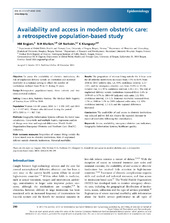| dc.contributor.author | Engjom, Hilde Marie | en_US |
| dc.contributor.author | Morken, Nils-Halvdan | en_US |
| dc.contributor.author | Norheim, Ole Frithjof | en_US |
| dc.contributor.author | Klungsøyr, Kari | en_US |
| dc.date.accessioned | 2014-12-09T16:49:28Z | |
| dc.date.available | 2014-12-09T16:49:28Z | |
| dc.date.issued | 2014 | eng |
| dc.identifier.issn | 1470-0328 | |
| dc.identifier.uri | https://hdl.handle.net/1956/8866 | |
| dc.description.abstract | Objective: To assess the availability of obstetric institutions, the risk of unplanned delivery outside an institution and maternal morbidity in a national setting in which the number of institutions declined from 95 to 51 during 30 years. Design: Retrospective population-based, three cohorts and two cross-sectional analyses. Setting: Census data, Statistics Norway. The Medical Birth Registry of Norway from 1979 to 2009. Population: Women (15–49 years), 2000 (n=1 050 269) and 2010 (n=1 127 665). Women who delivered during the period 1979–2009 (n=1 807 714). Methods: Geographic Information Systems software for travel zone calculations. Cross-table and multiple logistic regression analysis of change over time and regional differences. World Health Organization Emergency Obstetric and Newborn Care (EmOC) indicators. Main outcome measures: Proportion of women living outside the 1-hour travel zone to obstetric institutions. Risk of unplanned delivery outside obstetric institutions. Maternal morbidity. Results: The proportion of women living outside the 1-hour zone for all obstetric institutions increased from 7.9% to 8.8% from 2000 to 2010 (relative risk, 1.1; 95% confidence interval, 1.11– 1.12), and for emergency obstetric care from 11.0% to 12.1% (relative risk, 1.1; 95% confidence interval, 1.09–1.11). The risk of unplanned delivery outside institutions increased from 0.4% in 1979–83 to 0.7% in 2004–09 (adjusted odds ratio, 2.0; 95% confidence interval, 1.9–2.2). Maternal morbidity increased from 1.7% in 2000 to 2.2% in 2009 (adjusted odds ratio, 1.4; 95% confidence interval, 1.2–1.5) and the regional differences increased. Conclusions: The availability of and access to obstetric institutions was reduced and we did not observe the expected decrease in maternal morbidity following the centralisation. | en_US |
| dc.language.iso | eng | eng |
| dc.publisher | John Wiley & Sons Ltd on behalf of Royal College of Obstetricians and Gynaecologists | eng |
| dc.relation.ispartof | <a href="http://hdl.handle.net/1956/21286" target="blank">Obstetric care in Norway - the role of institution availability and place of delivery for maternal and perinatal outcomes. Population-based retrospective cohort studies</a> | |
| dc.rights | Attribution-NonCommercial-NoDerivs CC BY-NC-ND | eng |
| dc.rights.uri | http://creativecommons.org/licenses/by-nc-nd/3.0/ | eng |
| dc.title | Availability and access in modern obstetric care: a retrospective population-based study | en_US |
| dc.type | Peer reviewed | |
| dc.type | Journal article | |
| dc.date.updated | 2014-12-08T13:27:54Z | en_US |
| dc.description.version | publishedVersion | en_US |
| dc.rights.holder | Copyright 2013 The Authors | |
| dc.identifier.doi | https://doi.org/10.1111/1471-0528.12510 | |
| dc.identifier.cristin | 1126705 | |
| dc.source.journal | BJOG: An International Journal of Obstetrics & Gynaecology | |
| dc.source.40 | 121 | |
| dc.source.14 | 3 | |
| dc.source.pagenumber | 290-299 | |
| dc.subject.nsi | VDP::Medical sciences: 700::Clinical medical sciences: 750::Gynaecology and obstetrics: 756 | eng |
| dc.subject.nsi | VDP::Medisinske fag: 700::Klinisk medisinske fag: 750::Gynekologi og obstetrikk: 756 | nob |

